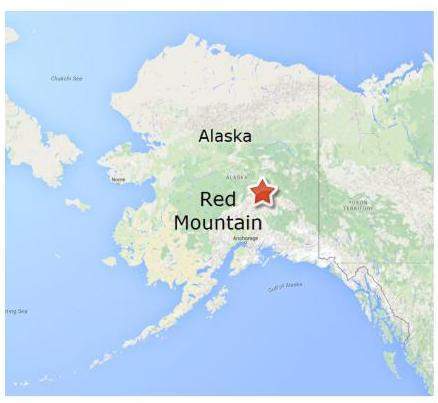Australia-based White Rock Minerals (WRM) said that initial drilling at the Hunter Prospect at its 100% owned Red Mountain Project in the Bonnifield Mining District in Alaska has confirmed zinc-rich massive sulphide discovery.

Image: Map showing location of the Red Mountain Project in Alaska. Photo: courtesy of White Rock Minerals Ltd.
Located in Red Mountain in central Alaska, the high-grade zinc polymetallic volcanogenic massive sulphide (VMS) Red Mountain Project is made up of 230 mining claims spread across a total area of 143km2.
White Rock Minerals encountered zinc-rich massive sulphide mineralization in the first two drill holes with the first of them – HR18-01 intersecting 1.4m of massive sulphide from 48.25m down hole. The second drill hole HR18-02 encountered 1.8m of massive sulphide from 60.84m down hole, said the Australian listed minerals resources exploration and development company.
According to the miner, the Hunter mineralization remains open at depth with drill testing yet to be taken up along strike to either the east or west.
It revealed that massive sulphide intersections at both the drill holes contain rich visual zinc (sphalerite) with minor chalcopyrite (copper) mineralization, similar to the discovery outcrop.
High grade zinc has been confirmed through the rock chip assay results from the Hunter discovery outcrop in the massive sulphide horizon with up to 18.6% Zn, 5.4% Pb, 2.3% Cu, 147g/t Ag & 0.7g/t Au, said White Rock Minerals.
White Rock Minerals MD & CEO Matt Gill said: “While Hunter is an exciting new discovery, drilling will also continue to test the other new targets identified from the ongoing reconnaissance mapping and geochemical sampling.
“What is exciting is that our on-ground recon crew has to date covered just 20% of our strategic tenement package of 143 square kilometres and already identified some seven areas of interest. That leaves a lot of upside for further discoveries.”
White Rock Minerals said that the Red Mountain Project hosts polymetallic VMS mineralization that is abundant in zinc, silver and lead, with potential for significant presence of gold and copper.
Past exploration activities at the VMS project had yielded the discovery of two deposits, namely Dry Creek and West Tundra Flats.
